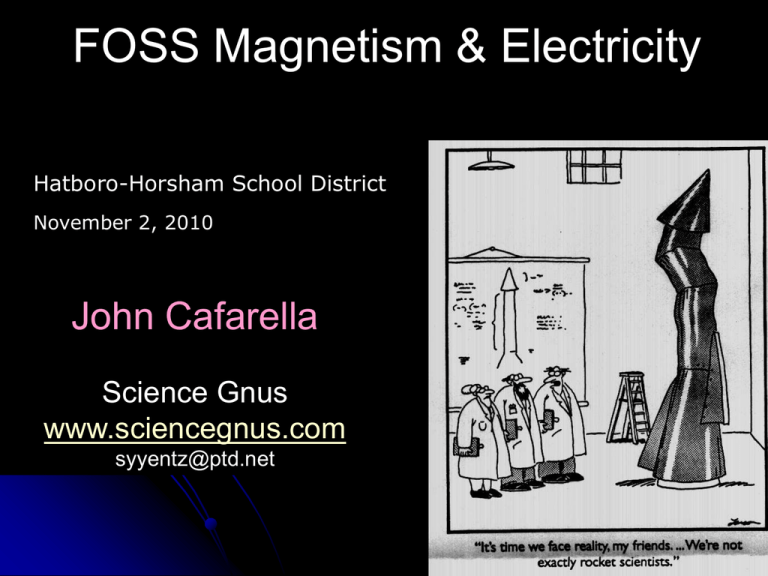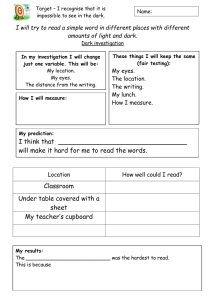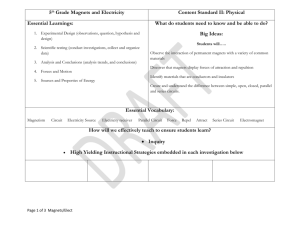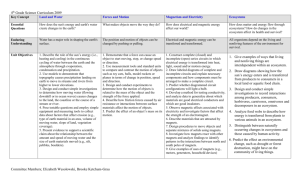Full Option Science System
advertisement

FOSS Magnetism & Electricity Hatboro-Horsham School District November 2, 2010 John Cafarella Science Gnus www.sciencegnus.com syyentz@ptd.net Vocal Puzzles Vocal Puzzles Solve the puzzles by saying them out loud, over and over, faster and faster, repeating the phrase, until you "hear" the answer. Example: LAWN SAND JEALOUS (place) Answer: Los Angeles 1. 2. 3. 4. 5. 6. 7. 8. 9. 10. 11. 12. 13. 14. 15. SHOCK CUSSED TOE (~a person~) SAND TACKLE LAWS (~a fictional character~) MY GULCH HOARD UN (~a person~) MOW BEAD HICK (~a book~) TALL MISCHIEF HER SUN (~a person~) ALP HURT TIE AN STY YEN ( famous scientist ) THOUGH TIGHT AN HICK (~a thing~) AISLE OH VIEW (~a phrase~) TUB RAID HEAP HUNCH (~a old TV show~) CARESS TROUGHER CLUMP US (~a person~) DOCKED HEARSE WHOSE (~a person~) THUMB ILL KEY WAKE OWL LICKS HE (~a place~) COUNTER RACK YULE AH (fictional character) MY COAL AND JELLO ( famous artist ) John Cafarella BUCK SPUN HE (~a fictional character~) Full Option Science System Purpose: Establish an understanding of the Magnetism & Electricity Module (including inquiry science), with a preliminary view of the investigations and assessments. Process –Use of Visual, Auditory and Tactile learning modalities: Module Inventory, Teacher Video, Notebooking, Activity set up, sample activities Payoff: Familiarity with Magnetism & Electricity Module Teacher’s Guide, Teacher Video, Kit inventory (materials), activity and activity materials management Goals MAGNETISM AND ELECTRICITY The Magnetism and Electricity Module consists of five sequential investigations, each designed to introduce or reinforce concepts in physical science. The investigations provide opportunities for students to explore the natural and human-made worlds by observing and manipulating materials in focused settings using simple tools. Story Line – Magnetism and Electricity •Investigation One: The Force: Four Parts Investigating Magnets and Materials Investigating More Magnetic Properties Breaking the Force Detecting the Force of Magnetism Investigation 2: Making Connections Lighting a bulb Making a Motor Run Finding Insulators and Conductors Investigating Mystery Circuits Investigation 3: Advanced Connections Building Series Circuits Building Parallel Circuits Solving the String-of-Lights Problem Investigation 5: Click It Reinventing the Telegraph Sending Messages Choosing Your Investigation Investigation 4: Current Attractions Building an Electromagnet Changing the Number of Winds Investigating More Electromagnets John Cafarella Question: What sticks to a magnet? Magnetism & Electricity Investigation 1 Part 1 “Describe the Object” – draw a picture of it Distribute magnets – what can you do with it? What can it stick to? Describe other magnets you have seen (establishes prior knowledge) What can a magnet stick to around your seat? Is there something that is the same about all the objects that the magnet sticks to? Bag of test objects (the “starter” collects all magnets and puts them in his/her desk”) Predict and then Sort into “things that stick and things that won’t. Test Discussion: Were you surprised by any of the objects you tested? Use student record sheet for something that is the same about all of the things listed in the “things that stick”. Iron is the only metal that magnets stick to How about the rock? Find metals that contain iron in the room Discuss- Start word bank Start content/inquiry chart Introduce Science Stories- Magnus Gets Stuck Pg. 1 Investigation 1 - The Force How could you use a magnet as an iron and steel detector? There might be objects in the room that are made of iron or steel. Your challenge is to find objects that are iron or steel and make a list of them. Which objects surprised you? Were thee any objects you thought might be iron, but were not? Did you find any steel that was hidden by paint or something else? How do you know? Break Point Investigation 1 – The Force What happens when two or more magnets interact? Introduce attract and repel Magnets on a pencil (four) Place them so that they all repel each other. What does it feel like when you push them? What is causing the magnets to push apart? That mysterious something between the magnets is a force. It is the magnetic force. When magnets pull toward one another and stick, it is a force of attraction; when the push apart, it is a force of repulsion. Vocabulary/Concepts Charts Word Bank Content/Inquiry Force Magnet Magnetism Attract Repel Magnets stick to iron Two magnets can attract or repel A force is a push or a pull. The New Curriculum Arrives Notes on School and Classroom Management • • The two most common elements in the universe are hydrogen and stupidity. Deja Moo: The feeling that you’ve heard this bull before. Vital papers will demonstrate their vitality by moving from where you left them to where you can’t find them. After All is Said and Done, a hell of a lot more is said than done. Law of Probability Dispersal: Whatever it is that hits the fan will not be evenly distributed. John Cafarella A Kepler Moment John Cafarella RETRIEVED MEMORIES ARE THE ONLY PROOF WE HAVE THAT LEARNING HAS TAKEN PLACE. Merilee Sprenger – Learning, Memory and the Brain Questioning Students When did you do Science today? Third Period Investigation 1 Part 2 – Investigating more Magnetic Properties Can you “chain” objects from the magnet Can a steel nail stuck to a magnet pick up a paper clip? Can a magnet attract a paper clip through a piece of paper, or through a piece of metal? Induced Magnetism – pg. 21 Investigation 1 Science Story – Magnificent Magnetic Models, pg. 5 FOSS Speak Folio – The Teacher’s Guide is divided into 10 sections. Each section is called a Folio. Each module is divided into Investigations The Magnetism & Electricity module has 5 Investigations. Each Investigation is divided into Parts. Each Part is (usually) a lesson John Cafarella “FOSS speak” John Cafarella So………… Thinking Inside the Box….. What’s In the Boxes? What do I do when I get these materials? Inventory the kit – materials lists are in T.G, on the box, and in the box, and tattooed on the delivery guy FULL OPTION SCIENCE SYSTEM MAGNETISM AND ELECTRICITY MATERIALS DRAWER 1—PERMANENT EQUIPMENT 8 Cardboard boxes 8 Compasses, magnetic 25 Cups, plastic 1 Bottle of iron filings . 36 Magnets 8 Magnets-on-a-post 8 Paper plates, small . 50 Spacers (plastic counters) 8 Bags of test objects, 38/bag (See page 3.) 8 Large washers, 20/bag 10 Zip bags, 1-liter . 1 Teacher Guide • FOSS Science Stories DRAWER 2—CONSUMABLE ITEMS 16 D-cells, alkaline 250 Recording dots, 1/2" EQUIPMENT CONDITION . . These items may need occasional replacement. NOTE: Make sure the Teacher Preparation Video is stored in Drawer 2, far from the magnets in Drawer 1. NOTE: After the kit has been used, look for precut wires in these lengths: 32 20-gauge wires, 15 cm 16 20-gauge wires, 30 cm 8 24-gauge wires, 150 cm FOSS Program Components What is in the Module? John Cafarella Investigation 1 Part 3 – Breaking the Force Can you find a way to measure the force of attraction between two magnets? How can the strength of the force of attraction between two magnets be measured? Here is the equipment: You’ll need the balance, two plastic cups, the magnet/on/a post, a magnet and washers Try to set up the experiment Set up a standard – where you place washers? How you lace washers? Does it matter if you drop them? Investigation 1 Part 3 – Breaking the Force Introducing the inquiry question I am going to give each group 5 additional What do you think will happen to the force spaces so you can continue your BUT!, I don’t want you test put of attractionexperiments. between 2 magnets iftoyou two spacers now. Skip over two spacers a plastic spacer between two attracting and test three, four, five,the and six spacers. a place two spacers your magnets? Leave Make a for T table to recordindata table Number of spacers Number of washers Vocabulary/Concepts Charts Word Bank Content/Inquiry Graph Prediction Intersection The greater the distance between two magnets, the weaker the force of the attraction Inquiry Focus Questions Investigation 1 Avoiding “Open Eye Coma” Most children can focus for a number of minutes equal to their age + 2 minutes. Therefore a 12 year old can focus for about 14 minutes. In fact adults cannot usually focus for more than 15-20 minutes. After this time the brain needs some time to process the information in a different way. Ideally we should confine learning activities within those focus minutes. But………….sometimes you need to go with the flow. It’s All a Matter of Perspective The Teacher’s Guide is Your Friend Developing a Deep, Meaningful Relationship With Your FOSS Teacher’s Guide Powers of 10 10 Folios 1. 2. 3. 4. 5. 6. 7. 8. 9. 10. FOSS Introduction Overview Materials *** Investigations Investigation Duplication Masters Assessment Assessment Duplication Masters Science Stories Resources FOSS Website Powers of 10 1 2 Pg. 18 Module Matrix Very nice but you don’t need it John Cafarella Synopsis Module Matrix Science Content Thinking Processes Interdisciplinary Connections FOSS Science Stories Technology/ Home Connection Suggested Schedule pg 16 - overview Week 1 2 The Force 3 1 session sessions 3 Making 2 2 Connections sessions sessions Advanced Connections Current Attractions Click It 1 session 4 5 6 7 8 3-4 Projects/ Summative Assessme nt 3 sessions 3 sessions sessions Powers of 10 3 4 Five Investigations Materials also listed on outside of module box Inside of Module box And at the beginning of each lesson (part) John Cafarella 5 Powers of 10 6 John Cafarella 7 Powers of 10 8 After the students have had experience with the materials John Cafarella Powers of 10 9 10 John Cafarella Investigation 2: Making Connections Part 1 – Lighting a bulb Note: First user of this Module has the “honor” of cutting the wires…… This is a D-cell - most people call it a battery – It is a source of electric energy. Source means a place to go where something is available, or where something comes from. This is a light bulb Observations (observation activity) Can you use a battery to turn on a light bulb? Use ONE wire Investigation 2: Making Connections Part 1 – Lighting a bulb The pathway through which the electricity flows from the D-cell to the light and back to the cell is a circuit. Can you light a light bulb with just one wire and a battery? Getters – get 2 bulb holders, 1 cell holder, and 1 circuit base for each group. Try to figure out how to use these materials to build a light bulb circuit in which you don’t have to hold all the pieces together. The part of the bulb that makes light is the filament. When electricity goes through the filament, it gets so hot that it gives off light. Watch the filament when the bulb lights up. Word Bank D-cell Battery Electricity source Electricity receiver Circuit Filament component Content/Inquiry A D-cell is a source of electric energy. A bulb is an energy receiver that produces light. To make a complete circuit, electricity must travel in a circle from one end of the battery to the other. Investigation 2 - Part 3 – Finding Conductors and Insulators – pg. 22 Can any of our test objects be used to complete a circuit? Start with JUST the straw and steel nail. Pg. 22 Definitions – conductor and insulator Science Stories – Making Static and A Fictional Interview With Benjamin Franklin Inquiry Focus Questions – Investigation 2 I think you should be more explicit here in step two Best Practices from the Far Side Assessment It’s not one size fits all……at least it shouldn’t be. Teaching from the Far Side Trying to do to much can be frustrating A Word About Homework The children were assigned to draw a picture of a parent at work (Here's the reply the teacher received the following day) Dear Mrs. Jones, I wish to clarify that I am not now, nor have I ever been, an exotic dancer. I work at Home Depot and I told my daughter how hectic it was last week before the blizzard hit. I told her we sold out every single shovel we had, and then I found one more in the back room, and that several people were fighting over who would get it. Her picture doesn't show me dancing around a pole. It's supposed to depict me selling the last snow shovel we had at Home Depot. From now on I will remember to check her homework more thoroughly before she turns it in. Sincerely, Mrs. Smith Best Practices from the Far Side It was an innocent mistake, but nevertheless, a moment later Maurice found himself receiving the full brunt of The mummy’s wrath. John Cafarella Correct use of hands-on manipulative materials is very important A Few Words About the FOSS Website http://www.fossweb.com/modules3-6/MagnetismandElectricity/index.html Let’s Go to the Video Tape http://lhsfoss.org/fossweb/schools/teachervideos/index.html Investigation 2 Part 2 – Making a Motor Run Note the Teacher video Materials Cookbook “Part” in practice includes teacher questions Collaborative Groups Pg. 8 - Overview Getters – responsible for materials. One person from each group (Getter 1) gets equipment from the materials station, and another person (Getter 2) returns it Starter- Job is to make sure that everyone gets a turn and that everyone has an opportunity to contribute ideas to the investigation Reporter- makes sure that everyone has recorded information on student sheets or in journals. Also reports group data to the class or records it on board or chart. Getter 1 Getter 2 Starter Reporter Assumptions Science and language arts instruction share many beliefs and goals. Science learning requires oral and written language. Language is learned through meaningful use. The connections between language arts and science instruction must be purposeful and explicit. Science and language arts are natural allies, not competitors for time and energy in the classroom. Karen Worth - EDC A Note on Science Notebooks Jeri Calhoun jeri_calhoun@charleston.k12.sc.us 843-852-3164 Ellen Mintz, NBCt ellen_mintz@charleston.k12.sc.us Selections from John’s 5th Grade Science Notebook •Science notebooks are not new. They have been around for a long time. a notebook accommodates multiple learning styles. There are drawings, math, and writing. Bill Gates recently purchased one of his notebooks Notice that mistakes are not erased. They are crossed out so he knows what works and what doesn’t. Students need to be encouraged to use this strategy when recording information to avoid repeating trials that have already proven unsuccessful. They are less likely to make the same mistake twice. Notebook Structures Table of Contents Page Numbering Documentation Glossary/Index Investigation 3 – Advanced Connections How can you make two bulbs light up with only one D Cell (battery) Part 1 – building series circuits Look at Pg. 4 – Series circuits and Parallel circuits Page 10 – Materials Page 11 – set up Part Page 12 – Do it……………Set up 2 bulb circuits Why do you think the lamps are dim in a series circuit? Can you make them brighter? Science Story – Iluminating Teamwork: A Story of the Edison Pioneers. Science Stories Folio Pg. 12/13 Investigation 4 – Current Attractions Part 1 – Page 8 – Materials for Building an Electromagnet Page 9 – Getting Ready (Set up) Can you make a rivet into a magnet that will turn on and off? – Note margin note pg. 11 lists materials for steps 4 & 5 Investigation 4: Current Attractions Part 2 – Changing the number of winds, Pg. 14 materials Page 15 – getting Ready No. 18 Student Sheet for graphing How can we find out if the number of winds of wire can make a difference in the strength of an electromagnet. Read Science Story: How Electromagnetism Stopped a War Electricity & Magnetism FOSSweb http://www.fossweb.com/modules3-6/MagnetismandElectricity/ Informational & Research Sites: http://edtech.kennesaw.edu/web/electric.html Investigation 5: Click It Part 1: Reinventing the Telegraph Page 8 – materials Page 9 – Getting Ready Pg. 10 sets the historical scene Can you make a telegraph? FOSS Materials Management Take Care of Your Materials and Your Materials Will Take Care of YOU Who will inventory kits after use? Who will order replacement materials? Who will get the replacement materials into the kit prior to next usage? List the hazards Story Line – Magnetism and Electricity •Investigation One: The Force: Four Parts Investigating Magnets and Materials Investigating More Magnetic Properties Breaking the Force Detecting the Force of Magnetism Investigation 2: Making Connections Lighting a bulb Making a Motor Run Finding Insulators and Conductors Investigating Mystery Circuits Investigation 3: Advanced Connections Building Series Circuits Building Parallel Circuits Solving the String-of-Lights Problem Investigation 5: Click It Reinventing the Telegraph Sending Messages Choosing Your Investigation Investigation 4: Current Attractions Building an Electromagnet Changing the Number of Winds Investigating More Electromagnets John Cafarella Design an Investigation Write an instruction booklet D cell durability Build an Alarm John Cafarella Stages of Professional Growth Stages of professional growth with new curriculum, program and/or new ways of teaching 1. orientation 2. mechanical use 3. refinement 4. integration 5. innovation The last 3 teachers adapt the strategies to the learner's needs, make new connections between strategies and outcomes, and create new strategies that improve student performance even further. Summary FOSS Module – Components Inquiry Teacher’s Guide – Powers of 10 Magnetism & Electricity - Investigations & Parts Five Investigations – Start with magnets, then electricity, then magnetism & electricity……electromagnets and telegraphs Stages of Professional Growth Science & Language Arts are Friends Curricula need 3-5 years to develop. Enjoy Yourself……It’s not Rocket Science….It’s good teaching The Most Important Component of the FOSS Program The Video or CD Rom No The Teachers’ Manual No The Hands on Materials No The Teacher A Reminder John Cafarella •Safety Reminders •Label “No Magnets Here” – TV, Computer and You •No magnets and/or wires in outlets •Make sure the Teacher Preparation Video is stored in Drawer 2 •………………………………..far from the magnets in Drawer 1. Remember, there is light at the end of the tunnel Science Gnus + The entire presentation is on pdf format at: www.sciencegnus.com http://www.sciencegnus.com/Presentations%20Gnus.html John Cafarella www.sciencegnus.com syyentz@ptd.net The Summative Assessment has three pieces: Matching/multiple choice/fill-ins Short response Explaining processes/thinking From Investigation 2 Making Connections Investigation 2 Part 4 PP. 27-28 Making Mystery Boards Need the 8 cardboard mystery boards in the kit. Fold them on the score – white side out Insert a paper fastener through each hole from the white side Label the fasteners A, B, C and D (on the white side) and number the boards 1-8 Follow the directions on Pg. 38 Science Stories: Two Reference Sources about Edison A Few Words About the FOSS Website http://www.fossweb.com/modules36/MagnetismandElectricity/index.html Teacher Resources Lunch John Cafarella Note: Sometimes the color will help with the clue John Cafarella Eye yi yi yi I Check Eye yi yi yi I Check Let’s Go to the Video Tape Investigation 3 – Part 3 The String of Lights Puzzle Investigation 4 – Current Attractions Part 1 – Building an Electromagnet Stuff Happens Bad Professional Development John Cafarella The word TEACH reflects as LEARN. •Notebook entry made by John Muir. Entry made by Beatrice Potter. In her time it was not acceptable for women to be a scientist and they, therefore were not encouraged to pursue science as a career. Her accuracy is evident in the drawings found in her books. Sentence Starters or Frames Using a sentence starter or a sentence frame supports the student’s writing as well as provides a focus for their ideas. It narrows the topic for the student. I used to think _____________________, but now I know __________________. One thing I will remember about today’s lesson is _______________________. I’m certain about _____________________________________________________, but I am uncertain about_______________________________________________. The reason I am uncertain is ____________________________________________. The new learning I feel I really understand is _____________________________. The part of solving the problem in today’s investigation that was challenging to me was ________________________________________________. When I started the investigation I knew ___________________________and now I also have learned _______________________________________________. Something I haven’t understood before that I understand now is ________. Next, I would like to explore ____________________________________________ because I wonder _____________________________________________________. I am amazed/puzzled by _______________________________________________. These results make me think ____________________________________________ will happen next because _____________________________________________. by Joanna Totino and Chris Sheridan K FOSS Grades K-2 Grades 1/2 Earth Science Life Science John Cafarella Physical Science FOSS Grades 3/4 Life Science Physical Science Earth Science Scientific Reasoning & Technology John Cafarella FOSS Grades 5/6 Earth Science Life Science Physical Science John Cafarella Scientific Reasoning Technology Thinking Processes Inferring Relating Organizing Comparing Communicating Observing Advanced Beginning John Cafarella Relating Organizing Comparing Communicating Observing Organizing Comparing Communicating Observing Comparing Communicating Observing Parking Lot I have to teach reading 189 hours per week. How many science lessons per week Who gets the teacher materials? I have to teach reading 189 hours per week. John Cafarella It’s All a Matter of Perspective John Cafarella From Administration From Teachers From Parents Directions should be clear John Cafarella Teaching From the Far Side Very clear John Cafarella Benchmark Assessments Occur in three places during a module. The survey is given before instruction begins, and includes 10-15 items, some open response and some multiple choice. I-Checks are given at the end of most investigations. Each I-Check consists of 5-10 items, in multiple formats. I-Checks are so named because students play an active role in checking their own understanding of the concepts being taught. The Posttest is given after the module has been completed. The items are the same ones that appear on the survey. Survey Assessment Pg. 4 The survey should be administered a few days before instruction begins. (This is “K” in the familiar KWL or KWHL lesson structure). Students need to know that the survey is not graded. At the end of the module they will have an opportunity to compare their answers on the survey with their posttest. When you administer the survey, encourage students to answer as best they can….even if they don’t know the answers, they should try to think about something related that they do know and apply the knowledge. Collect the surveys, code them for diagnostic purposes, but don’t make any marks on them. Hold them until after the students take the posttest. Formative Assessments can be: Teacher observation Student worksheets Journals Student Response sheets Performance assessments or Cooperative group assessments or selfassessments The Summative Assessment has three pieces: Matching/multiple choice/fill-ins Short response Explaining processes/thinking I-Check, Ipod, Iphone, I-Quit The I-Check Assessments I-Check assessments are administered after you complete most investigations. To track achievement (summative), code all the items using the coding guides in the folio. Recommended is one item at a time, across all students. It means a bit of paper shuffling but it allows you to think of the class as a whole and informs your teaching. You can also use the I-Checks for formative assessment. Have students complete the I-Check either unassisted or using a read-aloud strategy. Code the I-Check item by item….do NOT write the codes on students’ tests. Record the codes in a grade book or grading program. Return the I-Check to the students. There are several selfassessment strategies they can use. Choose what works best for you.



